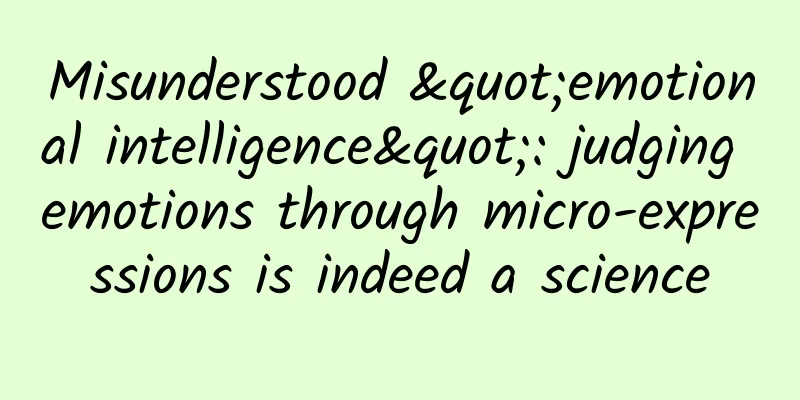Misunderstood "emotional intelligence": judging emotions through micro-expressions is indeed a science

|
Leviathan Press: "A wise man is honest and righteous, he observes words and looks, and considers others." The so-called "observing words and looking at faces" can be regarded as an image description of guessing and guessing others' inner thoughts through representations. This is also often used to describe those with high emotional intelligence - after all, judging the other person's emotions through micro-expressions is indeed a science. But what if the person in front of you has a "calm face"? Or, you think he (she) is in some kind of sadness, but it is actually the opposite? You’ve probably met people who are so good at managing their own emotions and understanding the emotions of others that they seem to keep their composure even when the sky is falling—they know exactly what to say and do when their boss is mad or their loved one is upset. Needless to say, emotional intelligence has been seen as another key predictor of success in life, even more important than IQ, since Daniel Goleman’s bestselling book Emotional Intelligence came out in 1995. After all, if one person can sense and respond to the full range of emotions, and another is always confused, who would you choose to work with? Who would you choose to date? The traditional concept of emotional intelligence is based on two common-sense assumptions. The first is that it is possible to accurately sense other people's emotions. That is, the human face and body are thought to convey happiness, sadness, anger, fear, and other emotions. If you look closely enough, you can read these emotions like the words in a book. The second assumption is that emotions are automatically triggered by things happening in the world and you can control them through reason - this view is the most valued view in Western civilization. For example, in many countries’ legal systems, a distinction is made between unplanned crimes—where emotions supposedly hijack the mind—and premeditated crimes, which involve careful planning. In economics, nearly every popular model of investor behavior also separates emotional and cognitive factors. These two core assumptions are very attractive and consistent with our daily experience. However, a large body of research from my lab and others shows that the face and body alone do not convey any particular emotion in a fixed way. Furthermore, we now know that there are no independent emotional and cognitive processes in the brain, nor that one controls the other. These statements may violate your common sense - and they do to me. However, no matter how convincing our own emotional experiences are, these feelings do not biologically reflect what is going on inside our bodies. Our traditional understanding and practice of emotional intelligence urgently needs to be adjusted. Let's start with the assumption that people can accurately sense other people's emotions. On the surface, this seems to make perfect sense, isn't it? Just by glancing at someone's face and body language, we can tell how they feel, right? Don't we know that a smiling face tells a different story than a scowl? Raised arms and a puffed chest may indicate pride, while a drooped posture generally indicates that someone is feeling sad. The big problem with this assumption is that faces and bodies don't move in such cartoonish ways in real life. Happy people sometimes smile and sometimes don't, and sometimes they even cry when they're happy (like at a wedding) and smile when they're sad (like when remembering a beloved aunt who passed away). Likewise, a person with a scowl might be angry, or just thinking hard, or even having indigestion. In fact, there's no specific, unchanging expression that conveys just one emotion. Many scientific studies have confirmed these observations. When we place electrodes on people's faces to record their muscle movements, we see that people's facial muscles move in different ways when they feel the same emotion. On the body side, hundreds of studies have shown that different people who feel the same emotion have different responses in heart rate, breathing, blood pressure, sweating, and other factors. There is no simple fixed response. Even in the brain, we see that different people who feel the same emotion (such as fear) in different situations - both in different experiments with the same person and in different people - process it differently. This diversity is not random, but is closely related to the situation you are in. In summary, when we try to identify emotions in others, faces and bodies don’t prove anything. Instead, variation is the norm. Your brain may automatically understand how someone behaves in a certain context, allowing you to guess how that person feels, but it’s always a guess, not an identification. Now, I may know my husband well enough to know that his scowl means he’s struggling over when I should get away from him, but that’s because I’ve had years to learn to see what his facial changes mean in different contexts. However, overall, people’s behavior varies greatly. To train emotional intelligence in a modern way, we need to recognize this variety and make sure the brain is equipped to automatically understand it. The second false assumption is that we can control our emotions through rational thinking. Emotions are often viewed as an inner beast that needs to be tamed through cognitive effort. However, this idea is rooted in a false view of brain evolution. Books and articles on emotional intelligence claim that you have a reptilian core, wrapped in a mammalian, brute, emotional layer, all wrapped in and controlled by a uniquely human, logical layer. This “three-layer” view, also known as “the triune brain,” has been popular since the 1950s but has no basis in reality. The brain didn’t evolve in layers, but rather like a company—it reorganized as it grew in size. The difference between your brain and that of a chimpanzee or monkey has nothing to do with layers, but with microscopic layout. Decades of neuroscience research have confirmed that there is no single specialized part of the brain responsible for thoughts or emotions; both are generated by the entire brain, with billions of neurons working together. Even though the “triune brain” is completely fiction, it has led to a remarkable movement in public discourse. Even now, decades after the “triune brain” idea was discarded by brain evolution experts, people still use terms like “lizard brain” and believe that emotions are tiny brain circuits that are triggered uncontrollably when they encounter the right external stimuli, and that at a deeper biological level, cognition and emotion are inextricably linked. After all, this is how many of us in Western cultures experience our emotional lives, as if our emotional side wants to do the impulsive thing, while our cognitive side suppresses the impulse. These convincing experiences—emotionally out of control and intellectually in control—do not reveal the underlying mechanisms in the brain. To better understand emotional intelligence, we must abandon the idea of the brain as a battlefield. A reasonable and scientifically based way to define and distinguish emotional intelligence comes from a modern neuroscience view of brain function called "construction": Researchers have observed that your brain automatically and instantly creates all thoughts, emotions, and perceptions as needed, completely unconsciously. It may seem that you have reflex-like emotional responses and can recognize the emotions of others effortlessly, but in the background, your brain is actually doing something completely different. Here’s a summary from a bird’s eye view: Your brain’s most important job isn’t to think, feel, or even see, but to keep your body alive and healthy so that you can survive, grow (and eventually reproduce). How does your brain accomplish this? It’s like a skilled fortune teller, constantly making predictions that ultimately become the emotions you experience and the expressions you interpret from others. Your brain exists entirely in your skull, a dark, silent box. It receives only sensory input from what's going on in the world—sights, sounds, smells, touches, and tastes from your body's receptors—and it has to guess at the cause of those sensations, because any sound, light, scent, or squeeze could have many different sources. Your brain makes these guesses based on past experience: What caused these feelings in similar situations in the past? What is needed to keep you alive and healthy? Your brain has an amazing ability to make predictions about what you are feeling best based on the current situation you are in, combined with snippets of past experience. Past experience is the prediction. Your brain is constantly predicting every experience you have and every action you take, making guesses about what is going on in the world and what you should do about it. From your brain's perspective, your body is just one of many sources of information it uses to understand the world: your heartbeat, your lungs expanding and contracting, your high body temperature from inflammation, and so on. These changes in your body have no objective emotional meaning. For example, a dull ache in your stomach could be due to nausea, anxiety, or just hunger. Therefore, your brain spends most of its time making microscopic predictions about your body's needs (water, glucose, salt) and trying to meet them before they occur. In the process, the brain also predicts the sensations that will be triggered by those physical changes, such as the feeling of your heart pounding in your chest, and the actions you should take at that moment. This natural and constant "storm" of predictions, completely beyond your conscious awareness, forms the basis of everything you think, feel, see, hear, or otherwise experience. This is how emotions, thoughts, and perceptions are formed. Therefore, emotional intelligence requires a brain that can use its predictive function to create a large, flexible range of complex emotions. If you are faced with a difficult situation that evokes past emotions, your brain will help you by constructing the most helpful emotion. If your brain has a wide range of emotions to choose from, you can handle the situation more effectively. If your brain can only come up with stereotypical examples such as "smile means happy, pout means sad", then these are all you can experience and perceive from others. But if your brain allows you to frown, smile, glare, squint, yell, brood in silence, or even connect with others in your anger, then your brain can more finely tune your feelings and behaviors to the situation. In other words, you have better tools for appearing emotionally intelligent. This ability is called emotional granularity, and my students and I discovered it about 20 years ago. We had hundreds of subjects record their emotions throughout the day using handheld computer devices (before smartphones). From this data, we found that even when people use the same emotion words, they are not necessarily expressing the same thing. For example, some people use "angry," "fearful," and "sad" to express completely different things, but others may use these three words in rotation to mean "feeling bad." Emotional granularity is a bit like wine tasting. Wine experts can discern extremely subtle differences even between batches of grapes from the same vineyard. Less experienced people may not taste these differences, but perhaps they can at least distinguish pinot noir from merlot from cabernet sauvignon. A beginner to wine may not be able to distinguish these differences - perhaps he can tell dry wine from sweet wine, or that both taste like wine. Similarly, those who display high emotional granularity are also emotional experts. Their brains can automatically construct subtle emotional experiences, such as surprise, surprise, shock, stunned, and astonishment. For a person with medium emotional granularity, the above words may all belong to the same concept: "surprise". For a person with low emotional granularity, these words may all correspond to high emotions. Emotional granularity is key to emotional intelligence. If your brain can automatically construct many different emotions and differentiate between them in detail, it will be better able to adjust your emotions to the situation, and you will also be able to predict and sense other people's emotions in a split second. The more emotions you know, the better your brain can automatically construct emotions from other people's behavior. Although your brain is always guessing, when it has more options, it has a higher probability of guessing correctly. How can you increase your emotional intelligence by enabling your brain to generate a wider range of emotions? One way is to learn more new words for emotions. Each new word sows the seeds of new emotional predictions in your brain, which your brain can use as a tool to construct your future experiences and perceptions, and then guide your behavior. Try to avoid generalizing that someone is "happy" and learn to distinguish more details. Are they "overjoyed," "contented," or "grateful"? Are they "angry," "indignant," "resented," or "resentful"? More refined emotions can prepare your brain for a range of different behaviors, while more general emotions (angry, happy, etc.) provide less information and limit your flexibility. The idea that you can improve your emotional intelligence by expanding your emotion vocabulary is a well-established neuroscience conclusion. Your brain isn’t static; it rewires itself with experience. When you force yourself to learn new words—emotional or otherwise—you rewire your brain’s microscopic structure so that it can more easily construct new emotional experiences and your perceptions of other people’s emotions in the future. In short, every emotion word you learn is a new tool for your future emotional intelligence development. People who can construct highly granular emotional experiences not only have advantages in social interaction. According to research by the Yale Center for Emotional Intelligence, children who expand their vocabulary related to emotions can improve both academic performance and social behavior. Adults with higher emotional granularity tend to be healthier, visit doctors less often, take fewer medications, and spend less time in the hospital. Foreign languages are a great resource for learning new emotion-related vocabulary and increasing your brain’s reserve of emotional capacity. You may already know “schadenfreude,” a German word that means “delight in someone else’s misfortune.” Other languages also have a host of emotion words that don’t have direct English equivalents, like the Filipino word “gigil,” which refers to the urge to squeeze something incredibly cute, or the Inuit word “iktsuarpok,” which refers to the feeling of anticipation and impatience when waiting for someone to arrive. When you learn about these foreign words and the concepts behind them, you may be able to sense these emotions in others, or even experience them yourself. Ironically, emotional intelligence is also about knowing when not to construct an emotion. When you feel overwhelmed, take a moment to come up with a non-emotional explanation for why you’re feeling that way. Maybe the knotty feeling in your stomach isn’t anxiety but determination, or maybe that annoying friend is just hungry. Feelings of worry when you’re talking to your mother don’t mean she’s saying the wrong thing. Remember, your brain is always guessing, and sometimes it will be wrong. When Emotional Intelligence hit the bestseller list 20 years ago, scientists didn’t know about the brain’s predictive function, didn’t know that the words you hear can influence your brain’s layout, and emotional granularity was a new discovery. After all, science is just our best understanding of how things work based on the evidence we have. In the face of new discoveries, explanations change, sometimes radically, and that’s how science works. Many factors that have traditionally been left out of the emotional realm—your vocabulary, for example—actually have a profound impact on how you feel, see, and act. To modernize the concept of emotional intelligence, we must understand what these factors are—even if they challenge common sense—and use them thoughtfully to understand each other and ourselves. By Lisa Feldman Barrett Translated by Carlyle Proofreading/Dragon Fruit Original article/nautil.us/issue/83/intelligence/emotional-intelligence-needs-a-rewrite-rp This article is based on a Creative Commons License (BY-NC) and is published by Carlyle on Leviathan The article only reflects the author's views and does not necessarily represent the position of Leviathan |
>>: In addition to the epidemic and the stock market crash, we may also encounter La Niña!
Recommend
Share: Legitimate online earning project - Classified Information Network 58.com earning tutorial
The 58.com money-making project is a very old mon...
Big data reveals the image of car owners: Cadillac and MINI are caught in the crossfire
Recently, AutoNavi Maps and the Ministry of Trans...
To do operations, you need to understand these "unspoken rules"!
In the eyes of marketers , this business world is ...
How to set up a Sogou bidding account and place Sogou ads?
1. Create a promotion plan The bidding account st...
B station advertising, B station advertising account opening process
It has become a reality that the vertical Z gener...
Tesla has 1,045 super charging stations around the world, but Didi drivers are not welcome to use them
From a certain perspective, as the world's mo...
[Live] Wang Jian, Technical Director of iFlytek Open Platform: How to create a natural human-computer interaction experience
[51CTO.com original article] Since the birth of c...
Analysis of the selection ideas for hot-selling products in the e-commerce industry
"On e-commerce platforms, choosing the right...
Comprehensive understanding of B-side product design: basic literacy
Today, the influence and role of the Internet are...
Data operation: customer portrait data analysis!
How can we use data to clearly profile existing u...
The best vegetables to eat in spring have so many benefits!
“The peaches and plums in the city are worried ab...
Land Rover Discovery is about to return to the city, but Toyota still wants to play hardcore off-road
Nowadays, the sales of hard-core off-road vehicle...
What are the functions of the Guangzhou WeChat Beauty Mini Program? How much does it cost to develop a skin care product mini program?
The most profitable industry nowadays is the &quo...
Tutorial on Creating a Mobile Interaction Design Checklist
For mobile applications, mobile scenarios are ver...









